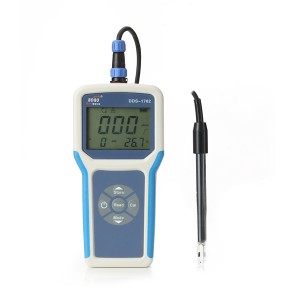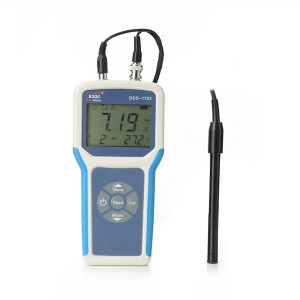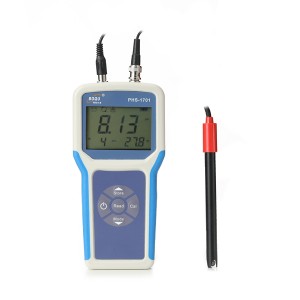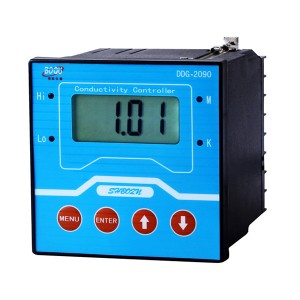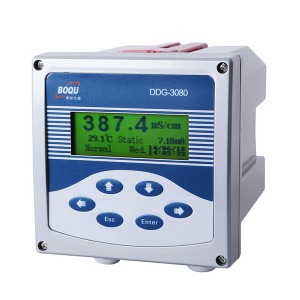DDS-1706 is an improved conductivity meter; based on DDS-307 on the market, it is added with the automatic temperature compensation function, with high price-performance ratio. It can be widely used for continuous monitoring of conductivity values of the solutions in thermal power plants, chemical fertilizer, metallurgy, environmental protection, pharmaceutical industry, biochemical industry, foodstuff and running water.
| Measuring range | Conductivity | 0.00 μS/cm…199.9 mS/cm | |
| TDS | 0.1 mg/L … 199.9 g/L | ||
| Salinity | 0.0 ppt…80.0 ppt | ||
| Resistivity | 0 Ω.cm … 100MΩ.cm | ||
| Temperature(ATC/MTC) | -5…105℃ | ||
| Resolution | Conductivity | Automatic | |
| TDS | Automatic | ||
| Salinity | 0.1ppt | ||
| Resistivity | Automatic | ||
| Temperature | 0.1℃ | ||
| Electronic unit error | EC/TDS/Sal/Res | ±0.5 % FS | |
| Temperature | ±0.3℃ | ||
| Calibration | One point | ||
| 9 preset standard solution (Europe, USA,China, Japan) | |||
| Power supply | DC5V-1W | ||
| Size/weight | 220×210×70mm/0.5kg | ||
| Monitor | LCD display | ||
| Electrode input interface | Mini Din | ||
| Data storage | Calibration data | ||
| 99 measurements data | |||
| Print function | Measurement results | ||
| Calibration results | |||
| Data storage | |||
| Use environmental conditions | Temperature | 5…40℃ | |
| Relative humidity | 5%…80%(Not condensate) | ||
| Installation category | Ⅱ | ||
| Pollution level | 2 | ||
| Altitude | <=2000 meters | ||
Conductivity is a measure of water’s capability to pass electrical flow. This ability is directly related to the concentration of ions in the water
1. These conductive ions come from dissolved salts and inorganic materials such as alkalis, chlorides, sulfides and carbonate compounds
2. Compounds that dissolve into ions are also known as electrolytes 40. The more ions that are present, the higher the conductivity of water. Likewise, the fewer ions that are in the water, the less conductive it is. Distilled or deionized water can act as an insulator due to its very low (if not negligible) conductivity value. Sea water, on the other hand, has a very high conductivity.
Ions conduct electricity due to their positive and negative charges
When electrolytes dissolve in water, they split into positively charged (cation) and negatively charged (anion) particles. As the dissolved substances split in water, the concentrations of each positive and negative charge remain equal. This means that even though the conductivity of water increases with added ions, it remains electrically neutral 2






